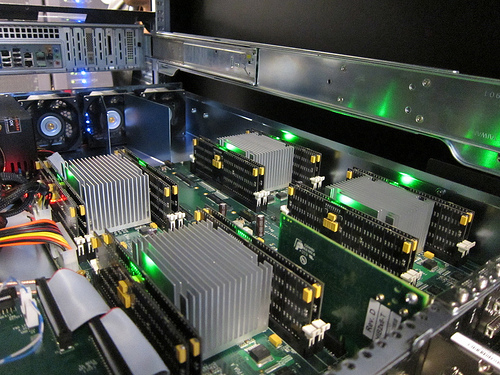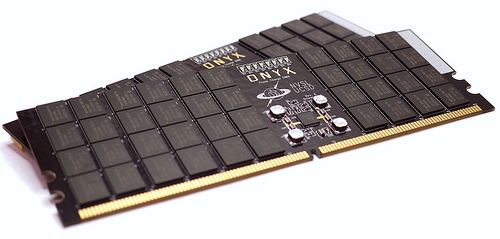Phase Change Memory-Based Moneta System Points to the Future of Computer Storage
San Diego, June 3, 2011 -- A University of California, San Diego faculty-student team is about to demonstrate a first-of-its kind, phase-change memory solid state storage device that provides performance thousands of times faster than a conventional hard drive and up to seven times faster than current state-of-the-art solid-state drives (SSDs).
|
Moneta will be on exhibit June 7-8 at DAC 2011, the world’s leading technical conference and trade show on electronic design automation, with the support of several industry partners, including Micron Technology, BEEcube and Xilinx.
The new type of storage system uses phase-change memory (PCM), an emerging data storage technology that stores data in the crystal structure of a metal alloy called a chalcogenide. PCM is faster and simpler to use than flash memory – the technology that currently dominates the SSD market.
Moneta marks the latest advancement in solid state drives (SSDs). Unlike conventional hard disk drives, solid state storage drives have no moving parts. Today’s SSDs use flash memory and can be found in a wide range of consumer electronics such as iPads and laptops. Although faster than hard disk, flash memory is still too slow to meet modern data storage and analysis demands, particularly in the area of high performance computing where the ability to sift through enormous volumes of data quickly is critical. Examples include storing and analyzing scientific data collected through environmental sensors, or even web searches through Google.
“As a society, we can gather all this data very, very quickly – much faster than we can analyze it with conventional, disk-based storage systems,” said Steven Swanson, professor of Computer Science and Engineering and director of the Non-Volatile Systems Lab (NVSL). “Phase-change memory-based solid state storage devices will allow us to sift through all of this data, make sense of it, and extract useful information much faster. It has the potential to be revolutionary.”
|
To store data, the PCM memory chips switch the alloy between a crystalline and amorphous state based on the application of heat through an electrical current. To read the data, the chips use a smaller current to determine which state the chalcogenide is in.
Moneta uses Micron Technology’s first-generation PCM chips and can read large sections of data at a maximum rate of 1.1 gigabytes per second and write data at up to 371 megabytes per second. For smaller accesses (e.g., 512 B), Moneta can read at 327 megabytes per second and write at 91 megabytes per second , or between two and seven times faster than a state-of-the-art, flash-based SSD. Moneta also provides lower latency for each operation and should reduce energy requirements for data-intensive applications.
A Glimpse at Computers of the Future
Swanson hopes to build the second generation of the Moneta storage device in the next six to nine months and says the technology could be ready for market in just a few years as the underlying phase-change memory technology improves. The development has also revealed a new technology challenge.
“We’ve found that you can build a much faster storage device, but in order to really make use of it, you have to change the software that manages it as well. Storage systems have evolved over the last 40 years to cater to disks, and disks are very, very slow,” said Swanson. “Designing storage systems that can fully leverage technologies like PCM requires rethinking almost every aspect of how a computer system’s software manages and accesses storage. Moneta gives us a window into the future of what computer storage systems are going to look like, and gives us the opportunity now to rethink how we design computer systems in response.”
The demo will be in Booth #2431 and will be running on Monday, Tuesday, and Wednesday at DAC 2011 in San Diego.
Related Links
Non-Volatile Systems Laboratory
Moneta Phase Change Memory Array
2011 Non-Volatile Memory Workshop
Computer Science at UCSD
2011 Design Automation Conference
Variability Expedition
Media Contacts
Catherine Hockmuth, Jacobs School of Engineering, 858-822-1359, chockmuth@ucsd.edu


